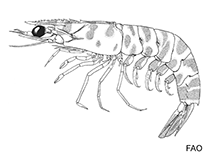Trachysalambria malaiana (Balss, 1933)
Brown rough shrimp
Hochladen Photos
Google Bild | No image available for this species;
drawing shows typical species in Penaeidae.
Google Bild | No image available for this species;
drawing shows typical species in Penaeidae.
Classification / Names Common names | Synonyms | CoL | ITIS | WoRMS
| Decapoda | Penaeidae
Environment: milieu / climate zone / depth range / distribution range Ökologie
; tiefenbereich 8 - 85 m (Ref. 116392), usually 60 - 60 m (Ref. 8). Tropical; 22°N - 45°S, 100°E - 154°E
Verbreitung Länder | FAO Gebiete | Ecosystems | Vorkommen | Einführungen
Indo-West Pacific: Malaysia to the Philippines and Australia.
Length at first maturity / Size / Gewicht / Alter
Maturity: Lm ? range ? - ? cm Max length : 6.3 cm TL Männchen/unbestimmt; (Ref. 8); 10.3 cm TL (female); max. veröff. Gewicht: 7.00 g (Ref. 116487)
Total length ranges from 4.7 to 6.3 cm (male); 3.2 to 10.3 cm (female). Carapace length: 1.25 cm (male); 2.3 cm (female) (Ref. 8). Juveniles inhabit subtidal edge of mud flats and far inshore waters (Ref. 121464). Pelagic, i.e. recorded in the water column (Ref. 106854).
Life cycle and mating behavior Geschlechtsreife | Fortpflanzung | Ablaichen | Eier | Fecundity | Larven
Members of the order Decapoda are mostly gonochoric. Mating behavior: Precopulatory courtship ritual is common (through olfactory and tactile cues); usually indirect sperm transfer.
Hauptreferenz
Referenzen | Koordinator | Partner
Holthuis, L.B. 1980. (Ref. 8)
IUCN Rote Liste Status (Ref. 130435)
CITES Status (Ref. 108899)
Not Evaluated
CMS (Ref. 116361)
Not Evaluated
Bedrohung für Menschen
Nutzung durch Menschen
Fischereien: weniger kommerziell
| FishSource |
Tools
Mehr Information
Internet Quellen
BHL | BOLD Systems | CISTI | DiscoverLife | FAO(Publication : search) | Fishipedia | GenBank (Genom, nucleotide) | GloBI | Gomexsi | Google Books | Google Scholar | Google | PubMed | Tree of Life | Wikipedia (Gehe zu, Suchen) | Zoological Record



